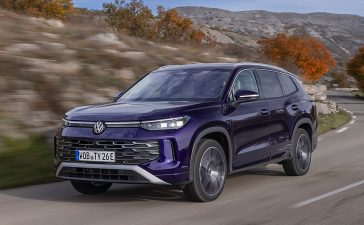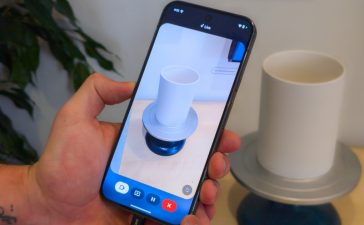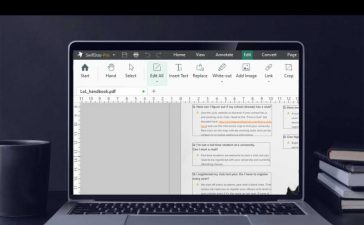It’s been three years since we last set foot on the CES show floor — and it feels very good to be back. The in-person portion of the conference was canceled in 2021 due to the coronavirus pandemic, and the omicron surge led to a much smaller event in 2022 than everyone had hoped for. But for 2023, the show’s energy was back, and so was its typical tidal wave of announcements.
This year’s show felt tangible in a way that CES often isn’t. The event is usually filled with far-out concepts, extravagant tech demos, and promises of gadgets working better together tomorrow — things that aren’t going to happen anytime soon or are wholly unaffordable. But this year, much of what we saw was exciting real tech coming into reach.
There were OLED monitors of all shapes and sizes. Accessibility was placed at the forefront of product design. Laptops got bigger, brighter, and bolder. Smart home gadgets actually worked together. Even concept cars picked up the word “prototype,” taking a step toward being a real thing.
It’s all been very exciting to watch — and play with, as you can see in our many hands-on stories and videos. And now, after a week of inundating ourselves with spec sheets, tuning in to press conferences, and trying out many of these gadgets for ourselves, we’re ready to crown our winner: the absolute best and most exciting things we saw at the show this year.
Best TV
Samsung’s 77-inch S95C
There’s been a ton of TV news at CES. Roku is making its own TVs. TCL will release an OLED TV this year. Sony was curiously MIA, but I’d expect to hear more about its plans soon.
Coming out of the show, my favorite TV planned for this year is no doubt Samsung’s S95C. It uses the second generation of Samsung Display’s QD-OLED panel, which is even brighter than last year and, so we’re told, more durable and power-efficient, too. QD-OLED can produce more vivid color at higher brightness levels than conventional OLEDs, like those used in LG TVs. It’s not a massive difference, but home theater nerds like myself can definitely see the added vibrance. The display can hit 2,000 nits of peak brightness — right up there with the very best Mini LED TVs — and can do 144Hz VRR gaming. It’s even got a powerful Dolby Atmos sound system built in. (But somehow there’s still no Dolby Vision. Sigh.) I think Samsung has learned a lot from 2022’s S95B OLED, and the second time around should be even better. Plus, this one comes in an even bigger 77-inch size. In short, this could be the best OLED TV yet — unless Sony comes along and beats it.
So that’s our winner for CES this year, but we think it’s also worth looking at the future — a future free of wires everywhere, a future where you can put your TV wherever you want — by discussing our honorable mention in this category. That’s where LG’s Signature OLED M really stood out in Las Vegas. This giant 97-inch 4K OLED gets all of its audio and video wirelessly from a small Zero Connect box that you can put anywhere in the room within 30 feet. You plug all of your gizmos and gaming consoles into that box, and everything is beamed to the screen — at up to 4K 120Hz, LG claims. The only cord you have to worry about for the TV is power. LG says this will give people a lot more freedom in where they put or mount the TV without all the usual headaches. But there are a lot of unknowns. For one, the OLED M is going to be super expensive. Also, the wireless tech is all proprietary, and I’m a little concerned about latency for you gamers out there.
But the exciting part is really the concept itself. Someday we’ll get to a point where this trickles down to mainstream TVs. When? Probably not until after people are driving their Sony cars. But it’s a glimpse of the future now, and that’s what CES is all about. – Chris Welch
Honorable mention: LG’s Signature OLED M
Best laptop
Lenovo’s Yoga Book 9i
I was skeptical about Lenovo’s Yoga Book 9i when the company first announced it on video. “Sigh, another weird dual-screen thing,” I thought to myself, and also, “Where is the touchpad?”
But seeing the thing in person changed my mind completely. This is a fun laptop to use. There’s a haptic touchpad and a haptic keyboard, there’s a detachable keyboard you can click on and off, and there are all kinds of gestures you can use to move your windows between the two screens, resize them, and make good use of the form factor. You can use it in all kinds of different positions, and I’m sure we only began to discover the available tricks during our brief time with the Yoga Book.
While we won’t know for sure until we’ve seen a unit, it looks like Lenovo has done excellent software work to make the Yoga Book a device that’s both pragmatic and a lot of fun. This is great innovation in a category where form factors and features are very, very established. – Monica Chin
Honorable mention: Razer’s Blade 16
Best monitor
Samsung’s Odyssey G95SC
Deciding on the best monitor at CES 2023 was really tough — there are a ton of exciting options at the show this year. But our pick goes to Samsung’s 49-inch Odyssey G95SC for delivering QD-OLED in a wacky new size. QD-OLED screens take contrasty OLED displays and make them even brighter and more color accurate. This monitor puts the tech in an ultrawide 32:9 aspect ratio with a 5120 x 1440 resolution. Games that support it should look awesome.
I’m also excited because this is one of a few OLED monitors at CES that has a glossy screen instead of an anti-glare coating, so colors and contrast should really pop. In addition to having all of the necessary ports (DisplayPort, HDMI 2.1) it has Samsung’s Gaming Hub interface, so you can connect a wireless controller to play games via Xbox Cloud Gaming and Nvidia GeForce Now, no PC or console necessary. – Cameron Faulkner
Honorable mention: Samsung’s ViewFinity S9
Best car
Sony Honda Mobility’s Afeela
Sony promised it would have an electric car to show off at this year’s CES, and it did, but I don’t think we were prepared for what we saw. Afeela — that’s right, Afeela — is the name that Sony gave its new lineup of EVs that it’s making with Honda.
Really rolls off the tongue, doesn’t it? Afeela.
Silly brand names aside, the car itself looked legit. It basically presents as a cross between a Porsche 911 and a Lucid Air — not the most unique design we’ve ever seen but very sleek, very shiny, and positively brimming with tech. Sony name-checked a bunch of big suppliers, including Epic’s Unreal Engine and Qualcomm, and promised 45 cameras and sensors to help with autonomous driving. It may even have a built-in PS5 at some point, because why not! Dream big, Sony. – Andrew J. Hawkins
Honorable mention: VW’s ID.7
Best far-out concept we actually want to become a reality
Samsung Display’s Flex Hybrid
Every CES is filled with futuristic gadgets that I’m super excited to know exist but that I would never actually buy for myself when (or even if) they make it to market. But when it comes to Samsung Display’s latest concept, the Flex Hybrid, I’d actually be very tempted. The Flex Hybrid combines both foldable and slidable form factors so, theoretically, you’d be able to unfold it for a small tablet-style experience and then slide it out further when you need a bigger screen.
Let’s see if any smartphone manufacturers are interested in turning Samsung Display’s concept into a reality. – Jon Porter
Honorable mention: BMW’s i Vision Dee
Best beauty tech
L’Oréal’s Hapta
Hapta is a prototype lipstick applicator that’s designed to help people with limited arm or hand mobility. It uses smart gestures and a nifty magnetic attachment that enables 360 degrees of rotation and 180 degrees of bending. The idea is to use existing stabilization technology — similar to the ones you’ll find in utensils designed for people with hand tremors — and apply it to cosmetics. This first iteration focuses on lipstick, but L’Oréal says it’s open to adding more forms of makeup down the line.
Makeup gives a lot of people some extra confidence and is often a form of self-expression. But it also requires fine motor skills — ask anyone who’s ever tried to freehand a winged eyeliner. No one has to wear makeup, but everyone should be able to if they want. In North America alone, there are over 58 million people with limited hand and arm mobility. This is a simple way to repurpose existing technology to make something most of us take for granted easier. – Victoria Song
Honorable mention: Neutrogena’s Skin360 Skinstacks
Best evolution of a concept
BMW’s i Vision Dee
Last year, BMW showed off an EV concept that could literally change color thanks to an exterior coating powered by E Ink. We loved it, but the monochromatic look — it could change from white to black to gray and that was it — left a lot to be desired. So it was very cool to see BMW come back this year with a similar concept that adds a whole new rainbow of color options.
The i Vision Dee can shift between 32 different colors thanks to its E Ink surface, and each segment can be individually controlled to present a different color. There’s also an AR windshield and a talking digital assistant that can express different moods. Will all of this tech ever make it into a production car? Probably not, but some of it certainly could. – Andrew J. Hawkins
Best gaming device
Sony’s Project Leonardo
One of the biggest gaming announcements of CES was a major surprise: a new accessibility-focused controller kit from Sony, codenamed Project Leonardo. The kit is designed to be highly customizable, letting you swap components like stick caps and buttons so that you can build a PS5 control setup that suits your needs. The device also has four 3.5mm auxiliary ports so that you can plug in third-party accessories that might be beneficial to you, and you can also use Project Leonardo in conjunction with a DualSense controller.
Right now, Sony is only saying that the kit is “in development,” so we don’t know when it might be released publicly. But even at this early stage, Project Leonardo looks to offer an incredibly flexible set of inputs that could be useful to many. And it’s good to see Sony following in the footsteps of Microsoft, which launched its own accessibility-focused Xbox Adaptive Controller in 2018. With two of the biggest gaming companies creating first-party controllers designed specifically for accessibility, they’re opening up video gaming to a lot more people. – Jay Peters
Honorable mention: Asus’ ROG Raikiri Pro
Most punnable name
Afeela
Mr. Stark, I don’t Afeela so good…
Names are hard. I should know given that my name sounds like it was generated by an algorithm trained on the birth certificates of a million boring British men. But Afeela? Did no one at Sony or Honda have a bad Afeela-ing about this one — or maybe think to put out some Afeelas to branding agencies for better options?
I don’t know about you, but I’ve got Afeela [Ed’s note: that’s enough now, Jon] that the name might not make it to Sony and Honda’s first production cars, which are set to go on sale in North America in 2026. – Jon Porter
Honorable mention: Matter (obviously)
Best smart home device
Aqara’s FP2 presence sensor
Yes. The best smart home device at CES is a small white sensor, one of the most boring devices in the smart home — but also the most crucial. The sensor that’s going to make smart home automation easier for the rest of us, the Aqara FP2 is a presence sensor that can accurately detect human presence from movements as slight as the rise and fall of your chest when breathing. This means no more waving your hands when the lights shut off because you were too still while reading your book.
Presence sensing is a big leap forward from passive infrared-based motion detection, which relies on big movements. The $60 FP2 uses mmWave radar tech, enabling one device to detect multiple people and monitor multiple areas within a single room simultaneously. This type of intelligent motion detection will help provide the smart home the context it sorely needs, enabling such specific automations as “turn on the light to reading mode when I sit in this chair by this lamp after 7PM” or “turn on all the lights when I get out of this bed after 7AM but not if there’s someone else in the bed.” – Jennifer Pattison Tuohy
Honorable mention: Nanoleaf’s Skylight
Best health tech
Withings U-Scan
It’s hard to not make immature jokes when talking about the Withings U-Scan, an at-home urinary lab that you stick in your toilet… and, well, pee on. But once the giggling subsides, you start to see that this is actually a thoughtful device that could make a lot of lives easier.
Medicine has come a long way, but we still have to collect urine samples ourselves (ew) and then ship them off to a lab to get results. How the U-Scan works is you pee normally, and then it collects a tiny sample using microfluidic circuitry. That’s then sent to a replaceable cartridge inside the reader, which contains 100 tests. Depending on the cartridge you get, you can test for things like ovulation windows, bodily pH, hydration, vitamin C, and ketone levels. Those results are then sent to your phone over Wi-Fi. For people with chronic metabolic health issues, like diabetes, you’d be able to monitor your ketones without actually having to do much at all. Not only is that pretty neat but it also holds a lot of potential for noninvasive remote patient monitoring. – Victoria Song
Honorable mention: Valencell
Best magnetically augmented wireless charging standard that’s not MagSafe
Qi2
Wireless charging is fickle, finicky, and far too easy to dislodge — and while Apple’s MagSafe brilliantly added magnets to the formula to ensure its brand of wireless charging wouldn’t get so easily thrown out of alignment, it’s got problems of its own. Namely, it’s tightly controlled by Apple and doesn’t work with other companies’ phones. (Reminder: Android is 70 percent of the world’s phones.)
Qi2 changes that. The new standard will make MagSafe-esque magnets part of the core specification for wireless charging. Apple and Samsung are both on board. Future Qi chargers should be able to snap onto Apple and Android phones equally. It’s the promise of a magical future where we all hold hands and things just work. – Sean Hollister
Best in show
Illustration: The Verge
Matter
CES was a Matter love fest, said one show attendee on Twitter — and they were not wrong. The new smart home standard, formerly known as Project CHIP, was showcased by Samsung and LG during their keynotes and graced all the silicon manufacturers’ and smart home gadget makers’ booths, big and small. Playing spot the Matter logo was like the easiest game of Where’s Waldo ever.
Matter is an interoperability standard that’s designed to be the missing piece that makes the smart home “just work.” It was announced in late 2019 as a partnership between Apple, Google, Samsung, Amazon, and others to solve the problems of the smart home. Just over three years later, the standard is here, and the big players are still working together to make it happen. Not all of the chatter on the show floor in 2023 was positive, however. The promise of broad backward compatibility with existing devices seems less likely, and for a standard designed to simplify the smart home, it is confoundingly complicated.
But one thing was clear: every company with a toe in the smart home is paying attention to Matter. And I have no doubt that it is the best chance for a more reliable, more secure, and (eventually) easier to use smart home across all devices and platforms, not just within walled gardens.
Now the challenge will be continuing that momentum to drive Matter to become as ubiquitous and recognizable a standard as Wi-Fi or Bluetooth. For that to happen, Matter will have to deliver on some of its promises very soon, and all those competitors will have to keep playing nice for a lot longer. – Jennifer Pattison Tuohy











